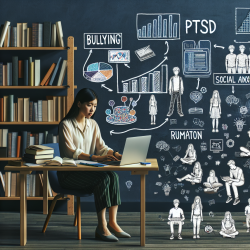Bullying in schools is a pervasive issue that can lead to severe psychological consequences for victims, including Post-Traumatic Stress Disorder (PTSD). A recent study titled "Association between bullying victimization and post-traumatic stress disorders among Chinese adolescents: a multiple mediation model" published in BMC Psychiatry offers valuable insights into the mechanisms linking bullying victimization to PTSD. This blog will explore how practitioners can leverage these findings to improve their therapeutic interventions for adolescents affected by bullying.
Key Findings from the Research
The study examined the relationship between bullying victimization and PTSD among Chinese adolescents, focusing on the mediating roles of social anxiety, loneliness, and rumination. The research involved 5013 students, with 443 identified as bullying victims. Key findings include:
- Bullying victimization is directly associated with PTSD.
- Social anxiety and loneliness significantly mediate the relationship between bullying victimization and PTSD.
- Rumination mediates the relationship between bullying victimization and PTSD, but only when combined with social anxiety and loneliness.
Implementing Research Findings in Practice
To create effective interventions, practitioners should consider the following strategies based on the study's outcomes:
Address Social Anxiety
Social anxiety plays a critical role in the development of PTSD among bullying victims. Practitioners can:
- Incorporate cognitive-behavioral therapy (CBT) techniques to help adolescents reframe negative thoughts and reduce social anxiety.
- Encourage participation in social skills training to build confidence in social interactions.
Mitigate Loneliness
Loneliness exacerbates the impact of bullying on PTSD. Practitioners can:
- Promote peer support groups where victims can share experiences and feel less isolated.
- Encourage activities that foster positive peer relationships, such as team sports or group projects.
Reduce Rumination
Although rumination alone is not a significant mediator, it becomes crucial when combined with social anxiety and loneliness. Practitioners can:
- Teach mindfulness and relaxation techniques to help adolescents manage stress and reduce rumination.
- Use narrative therapy to help victims process their experiences and develop healthier coping mechanisms.
Encouraging Further Research
While this study provides valuable insights, further research is needed to explore the complex interactions between emotional and cognitive factors in bullying victimization and PTSD. Practitioners are encouraged to stay updated with the latest research and integrate evidence-based practices into their therapeutic approaches.
Conclusion
Understanding the mediating roles of social anxiety, loneliness, and rumination in the relationship between bullying victimization and PTSD is crucial for developing effective interventions. By addressing these factors, practitioners can better support adolescents in overcoming the psychological impacts of bullying and reduce the risk of PTSD.To read the original research paper, please follow this link:
Association between bullying victimization and post-traumatic stress disorders among Chinese adolescents: a multiple mediation model.










